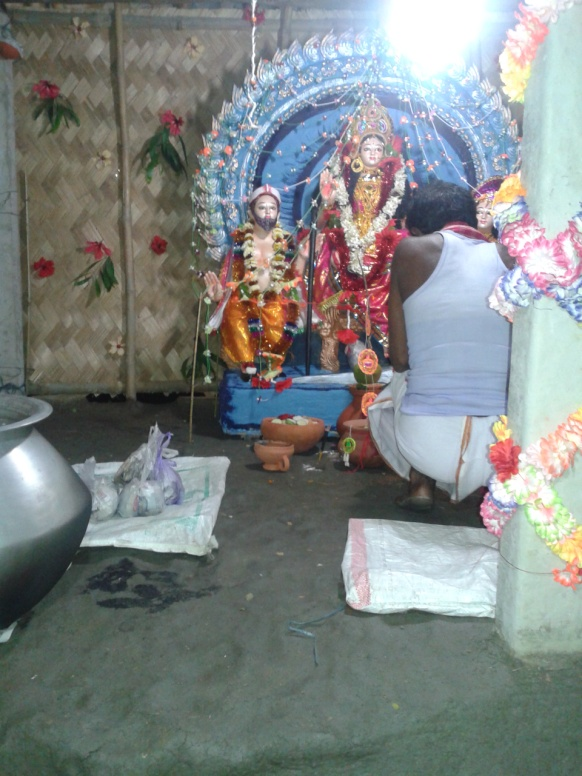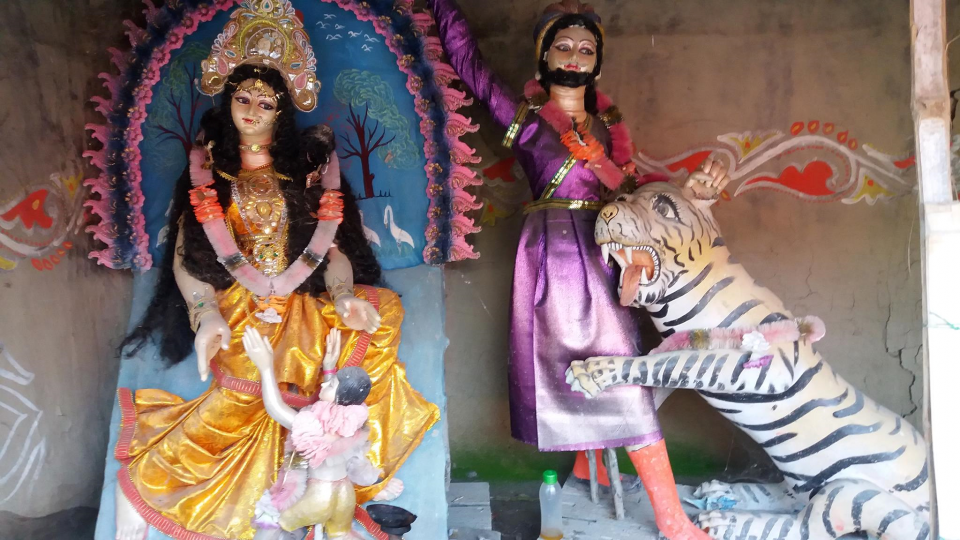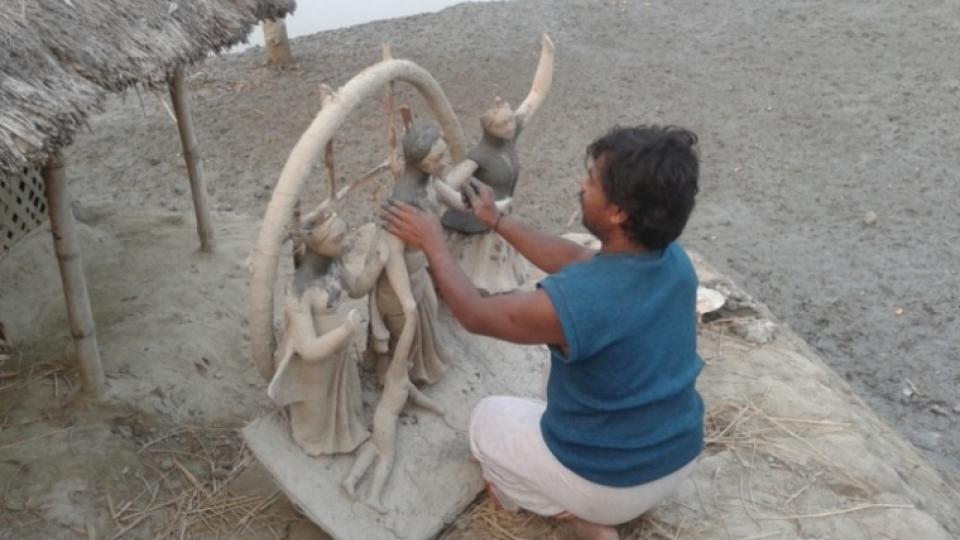Bipod e poriya bon e jeijon e daak e, Ma boliya Bonbibi doya r maa take … Uddhariye taro torey aponaro gun e, Maaer o hujura koto likhibo ekhane …
[Facing any danger inside the forest, whoever prays to Her,
Mother Bonbibi protects them all.]—Bonbibi Johuranama
The above excerpt from Bonbibi Johuranama (hereafter Johuranama), which narrates the story of “Bonbibi,” is chanted in the forest fringe villages of the Sundarbans, before the honey collectors and fish workers enter the forest. Commonly known as “forest workers,” these people have, throughout history, ventured into the forests for livelihood. The only protection that they carry with them is the sacred blessing of the forest goddess Bonbibi.

The temple of Bonbibi in a village called Emilibari, with a priest making arrangements for worship.
The temple of Bonbibi in a village called Emilibari, with a priest making arrangements for worship.
Photograph by Amrita Sen.
 This work is licensed under a Creative Commons Attribution 4.0 International License.
This work is licensed under a Creative Commons Attribution 4.0 International License.
The Sundarbans has a unique legacy of human settlements—notably the advent of the Mughals, as well as the Portuguese and the Magh pirates invading from the Arakan coast—which has resulted in a mixed ethnic identity of Buddhists as well as Muslims (Chatterjee Sarkar 2010). The history of settlements is further explored through the accounts of Eaton (1990), who elaborated on the influence of the Mughal Empire in lower Bengal, particularly on the Muslim saints, who extended the delta’s arable land between 1204 and 1765. A wide body of folk literature, written during the period, points to the presence of supernatural powers in the Sundarban forests. The most notable among this literature is the Johuranama, written by Abdur Rahim in the late nineteenth century, through considerable adaptations from an epic poem from 1686 called Ray-mangal by Krishnaram Das (Jalais 2008: 7).
The imagination of Bonbibi as a forest goddess and the “religion of the forest” this has shaped is intricately manifested within everyday lives—it underscores local ecological knowledge, customary rights, and a deep-seated belief system. At the core of such a place-based religious framing is a unique perspective highlighting sustainable practices and ecological resilience. Forest workers typically follow norms of access to forest areas and do not extract more than they need. These norms include entering the forest during certain hours of the day and refraining from entering at night so as not to agitate the wildlife, refraining from defecating and smoking within the forest, and entering the forest in “clean hands”—i.e., without any arms. Forest workers do not catch fish during certain breeding seasons and do not extract wood or honey from small flowering trees.

Bonbibi with little Dukhe, Shah-Janguli, and Dakshin Ray, here appearing as a tiger.
Bonbibi with little Dukhe, Shah-Janguli, and Dakshin Ray, here appearing as a tiger.
Photograph by Amrita Sen.
 This work is licensed under a Creative Commons Attribution 4.0 International License.
This work is licensed under a Creative Commons Attribution 4.0 International License.
Johuranama describes the birth of Bonbibi and her brother Shah-Janguli, and their fight with Narayani, the mother of Dakshin Ray, for the possession of the mangrove forests of the Sundarbans. Dakshin Ray, the son of a Brahmin priest called Dandabakhya and his wife Narayani Devi, was a clairvoyant who, through his mythical powers, was able to assume different forms, primarily that of a tiger. The Johuranama consists of the Dukhe Jatra (the journey of Dukhe), or a narration of the ways in which the life of a small child called “Dukhe” was saved from the hands of Dakshin Ray by Bonbibi. Forest workers identify themselves with poor Dukhe before venturing inside the forests and pray to Bonbibi to safeguard them against potential threats of tiger attacks.
What appears representative of the regional folk tales regarding Bonbibi is an intrinsic adaptive capacity of the local people, in the form of their traditional ecological knowledge and their adaptability to the inhospitable forests. The religion guides communities to extract resources for survival with a “ritual demonstration” of the worship practices (Uddin 2019: 300). “Tiger charmers” or bawalis (locally), are people who are adept at the process of demonstration, guiding forest workers, especially honey collectors, inside the forests. They are also believed to control storms or prevent ailments, along with having the power to drive away tigers and evil spirits inside the forests (Jalais 2010: 76).

A local fisherman carving an idol of Bonbibi beside the Gomor River.
A local fisherman carving an idol of Bonbibi beside the Gomor River.
Photograph by Amrita Sen.
 This work is licensed under a Creative Commons Attribution 4.0 International License.
This work is licensed under a Creative Commons Attribution 4.0 International License.
Bonbibi worship might not have transcended the local barriers of the Sundarban islands to reach the domains of popular religious practices in the mainland cities. But it preaches virtues of forest conservation. Conservation norms safeguarding this largest coastal mangrove forests must recognize place-based customary norms, since an isolated body of scientific conservation policies would be inadequate to address the challenges posed by the vulnerable ecology. Bonbibi worship is significant in underscoring place-based framings on environmental consciousness in specific conservation landscapes, where the dominant conservation ethic is rooted in state-led legal provisions.
How to cite
Sen, Amrita, and Jenia Mukherjee. “Bonbibi: A Religion of the Forest in the Sundarbans.” Environment & Society Portal, Arcadia (Summer 2020), no. 22. Rachel Carson Center for Environment and Society. https://doi.org/10.5282/rcc/9051.
ISSN 2199-3408
Environment & Society Portal, Arcadia
 This work is licensed under a Creative Commons Attribution 4.0 International License.
This work is licensed under a Creative Commons Attribution 4.0 International License.
2020 Amrita Sen & Jenia Mukherjee
This refers only to the text and does not include any image rights.
Please click on the images to view their individual rights status.
- Chatterjee Sarkar, Sutapa. The Sundarbans: Folk Deities, Monsters and Mortals. New Delhi: Orient Blackswan, 2010.
- Eaton, Richard. M. “Human Settlement and Colonization in the Sundarbans: 1200–1750.” Agriculture and Human Values 7, no. 2 (1990): 6–16.
- Jalais, Annu. “Bonbibi: Bridging Worlds.” Indian Folklore 28 (2008): 6–8.
- Jalais, Annu. Forest of Tigers: People, Politics and Environment in the Sundarbans. New Delhi: Routledge, 2010.
- Mandal, Sujit Kumar. Bonbibir Pala. Kolkata: Gangchil Publishers, 2010.
- Uddin, S. M. “Religion, Nature, and Life in the Sundarbans.” Asian Ethnology 78, no. 2 (2019): 289–309.









